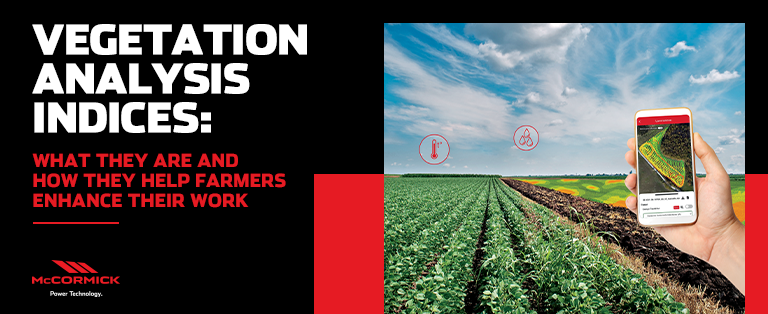VEGETATION ANALYSIS INDICES: WHAT THEY ARE AND HOW THEY HELP FARMERS ENHANCE THEIR WORK

Table of contents:
Through the use of digital technologies and advanced analysis tools, precision farming has advanced rapidly in recent years. This progress is largely due to vegetation indices, which are mathematical indicators used to assess crop health, photosynthetic efficiency, and biomass development.
However, what exactly are vegetation indices, how do they work, and why are they so important to field workers?
What are vegetation indices
Vegetation indices are formulas that combine light reflectance values captured by optical sensors across different bands of the electromagnetic spectrum, such as visible and infrared. In simple terms, these tools transform data collected by drones, planet gears, or sensors mounted on tractors/implement into useful information for monitoring crop health.
In fact, depending on their state of health, plants reflect light differently. Plants that are healthy reflect most of their energy in the near-infrared (NIR) band and little in the red band, while plants that are stressed or unhealthy reflect the opposite energy. In combining these measurements, it is possible to obtain a clear and detailed view of the field, often in the form of colour maps that highlight the most productive areas and those that are problematic.
The main vegetation indices
Among the most commonly used indices in agriculture are:
- NDVI (Normalized Difference Vegetation Index): this is the most well-known and widely used index. It ranges from -1 to 1 and allows for a quick estimation of vegetative health. Values close to 1 indicate healthy, active vegetation, while low values indicate stress or absence of vegetation.
- GNDVI (Green NDVI): a variant of NDVI that uses a green band rather than a red band, useful to detect nutritional or water stress at an early stage.
- SAVI (Soil Adjusted Vegetation Index): particularly suitable for underdeveloped crops or very exposed soils, as it corrects the influence of bare soil.
- EVI (Enhanced Vegetation Index): optimised for vegetation-rich areas, it reduces the effect of airborne particles (such as dust or smoke) and offers increased accuracy under certain conditions.
What are they used for in regular operations
Using vegetation indices, farmers are able to monitor crop development in real time, intervene early in the event of a problem (such as water stress, pest attacks or nutritional deficiencies), and plan targeted interventions. This translates into::
- Reducing resource consumption (water, fertilisers, pesticides)
- Yield optimisation
- Reduction of environmental impact
- Cost savings
Moreover, this information becomes crucial for traceability and sustainability in business management and documentation.
Digital technologies at the service of agriculture
Nowadays, thanks to integrated solutions, such as those offered by McCormick Digital Solutions – and especially the McCormick Farm app – it is possible to easily gather, process, and interpret data from vegetation indices, directly through systems installed on tractors or via connected platforms.
McCormick Farm offers farmers an accurate overview of soil and crop conditions as well as data collection and management, enabling them to make fast, informed decisions. Combining assisted driving and yield mapping systems, we enter a new era of agriculture that is more efficient, sustainable, and intelligent.
Conclusions
The use of vegetation analysis indices is today an essential tool for those wishing to cultivate in a modern and conscious manner. By combining technology and agronomy, they help prevent issues, improve yields and protect the environment. With the help of the most advanced digital solutions – such as those offered by McCormick – even the most traditional farms can advance into the future of agriculture.
